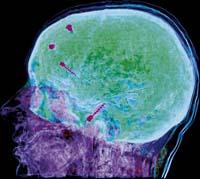It makes us words

Until 1950-60, the complexity of language was due to the extent of the human brain that had spread. Thus, the difference between animal communication systems and language was based solely on "machine power".
However, his research has shown that language is not a sophisticated version of animal communication systems, and that the size of the brain itself is not enough to explain the peculiarities of language. According to Itziar Laka, a linguist at the UPV, "there is something else." Something that the communication systems of the other species do not have.
To explain it, Laka mentions the vocalizations of primates. In fact, chimpanzees and other primates use vocalizations, mainly to express emotions: fear, anger, I'm happy. "We also have our vocalizations," says Laka, "and they are, ene, sos, ostia. They are associated with emotional situations, we do not control well. For in people who normally use the right hand, the area of vocalizations is located in the right hemisphere, as is that of the primate vocalizations. On the contrary, the language is located in the left hemisphere. Therefore, language is not a development of vocalizations, it is something else."
Another characteristic of language is that it serves to express concepts and facts. Some animals also have concepts and concept maps, and they know what an event is, but they cannot expel them by giving a concrete way for others of their kind to know them. "We do. Chimpanzees, birds, bees, ants, each have their own communication system. But they are limited, they can only express certain things; depending on the species, it can be where the food is, where the danger comes from... We are the only ones who have the ability to express concepts and facts without limits."
Elegance is not the case
In addition to this expressive ability, only the person has the ability to make a possible thought (counter-current). This has a great importance in the nature of our species, which allows to transmit culture, for example, or to devise what one is in the head of another. Well, in Laka's words, it is demonstrated that possible thought is directly related to language; "even more, according to what we know now, language allows this type of thought."

On the other hand, the structure of the language is special. It is based on discrete parts, words, and is combinatory. Laka equates words with pieces of legumes: "Like them, they are discreet and combine to create increasingly complex structures." Many linguists claim that it is a fractal structure; Laka compares it to matriuskas. In any case, the architecture of language seems "elegant" to him.
It is elegant and effective. In fact, thanks to combinatorics, the number of words to learn is small, but it offers a great opportunity to create long and complex proposals. "And that at full speed. The design allows this speed."
From titles to small print
Researchers still do not know if the language computing system is a consequence of the brain or if there is something else in the interval. This is one of your answer questions. However, they know more and more things; according to Laka, "the headlines are at top, although I don't like them much, because we know that things are much more complex in themselves."
However, Laka gives an example of a classic title about two areas of the brain related to language, Broca and Wernicke. The title is: Broca has to do with the syntax and morphology of words and Wernick with the meaning of words. "But what we know is more complex than the title. And also more interesting."
With the new techniques of neuroimaging, researchers have recently come to see inside Broca where and when phonological processing of a verb is performed, where and when morphological, and where and when semantic. This has shown that the model used to explain the processing is correct.

In addition, in other studies they have seen that Broca computes other non-linguistic things. According to Laka, "some are not surprising, and those are music and mathematics. Both are characteristics of our species and it is evident that the three are related." He is surprised by Broca's participation in complex actions. "It is not yet well known, but it is possible that the function of Broca is to make a type of computing that reflects the language, so justly, but not only that of the language."
Wernicke is less known than Broca. What they do know is that patients affected by Wernick have a very direct syntax, but that the meaning of the sentences cannot be appreciated. It is not known whether patients are aware of it. On the contrary, those who have Broca aphasia know what they mean, but they cannot express it well (they have some telegraphic speech) and realize their impotence.
On the other hand, these two areas are found in the bark, although they are known to be connected below. Thanks to current methods, researchers are studying these connections. Laka is convinced that this will soon involve a greater knowledge of the keys to the language.
The language gene?
Another language related title is that FOXP2 is the language gene. Although it is too simple to say that, anthropologists have drawn truly important conclusions from the study of this gene, and for linguists it is essential to explain some of the characteristics of the language.

Genetic studies have shown that other animals also have the FOXP2 gene. In addition, it is related to the homologous singing to the FOXP2 that appear some birds. However, the other species do not present the mutation of the person's FOXP2 gene.
However, in the Neanderthal genetic code there is this mutation, so many experts believe that Neanderthal could have a language. Thus, it seems that the language arose much earlier than previously thought.
In any case, the FOXP2 gene has to do with the ability to plan movements and compute sequences. And this may be related to the ability to create the fractal structure of language. But it's not enough to create a language. "Another miracle is needed, something else to explain another key to language," Laka warns. "What mutation does the interface that relates concepts to form allow? ". Laka finds this ability "fascinating". But it is still an unsolved mystery.
Buletina
Bidali zure helbide elektronikoa eta jaso asteroko buletina zure sarrera-ontzian











